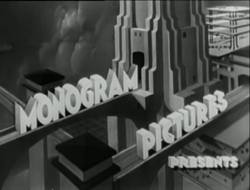Background[]
Monogram Pictures was formed in 1931, a consolidation of "Raytone Productions" (headed by W. Ray Johnston first as "Rayart Productions") and "Sono Art-World Wide Pictures" (under Trem Carr), both of whom specialized in low-budget fare. Their main forte was Westerns (in fact, Monogram distributed Paul Malvern's Lone Star/Republic Pictures, under the sway of Consolidated Film Industries head Herbert Yates. The new studio was a success, but Johnston and Carr both bolted in 1937. While Carr went on to produce for the "new" Universal (read: post-Laemmle), Johnston relaunched Monogram. Again specializing in the B-Western, it was one of the most successful studios on Hollywood's so-called "Poverty Row." Acting on advice from producer Walter Mirisch (who convinced studio chief Samuel Broidy that the glory days of the B-movie were ending), Monogram spun off a big-budget entity called westerns, many starring a young John Wayne, but produced in other genres as well. In 1946, Monogram joined with a few other small studios to form "Allied Artists Productions", while continuing to make smaller-budget films under the Monogram aegis. In September 1952, Monogram announced that all its output would be released under the Allied Artists banner. The final Monogram picture came out in early 1953. Allied Artists filed for bankruptcy in 1979, due to high production costs, increased competition and runaway inflation. The Monogram/Allied Artists catalog was purchased by Lorimar-Telepictures the following year. Today, most of them are owned by Warner Bros. Pictures; however, Paramount Global-owned Paramount Pictures through Melange Pictures, LLC. handles the pre-1936 Monogram library.
1st Logo (1932-1935)[]
Nicknames: "The Streamliner", "The Bullet Train"
Logo: As an animated airplane and dirigible fly overhead in opposite directions, a streamlined passenger train towing the word "MONOGRAM" comes in from the upper right. It continues on, leaving the word behind. Then, from the lower left, another train appears, towing the word "PICTURES"; similarly, the train moves on, leaving its word behind. After this, the word "PRESENTS" appears at the lower-right.
FX/SFX: The movement of the planes, dirigibles and trains.
Music/Sounds: Usually the opening stanzas of the film's theme, but sometimes only the motors of the vehicles, a la the 1927 Universal logo.
Availability: Rare.
2nd Logo (1937-1953?)[]
Nicknames: "The Spinning Disc", "MPC"
Logo: A metallic-looking disc rotates counter-clockwise against a cloudy sky backdrop. The studio's name and logo is superimposed on this disc; it remains stationary, as does a dark frame with sixteen stars which surround the disc.
Closing Variant: A still shot of the logo with the text "The End" in a script font with the text "A MONOGRAM PICTURE" or "A MONOGRAM PRODUCTION" underneath the text.
FX/SFX: The disc spinning, the clouds moving.
Music/Sounds: A dramatic, regal-sounding fanfare.
Availability: Scarce. Seen on Monogram flicks from the time. Some movies cut directly to the opening or have television distribution logos.



